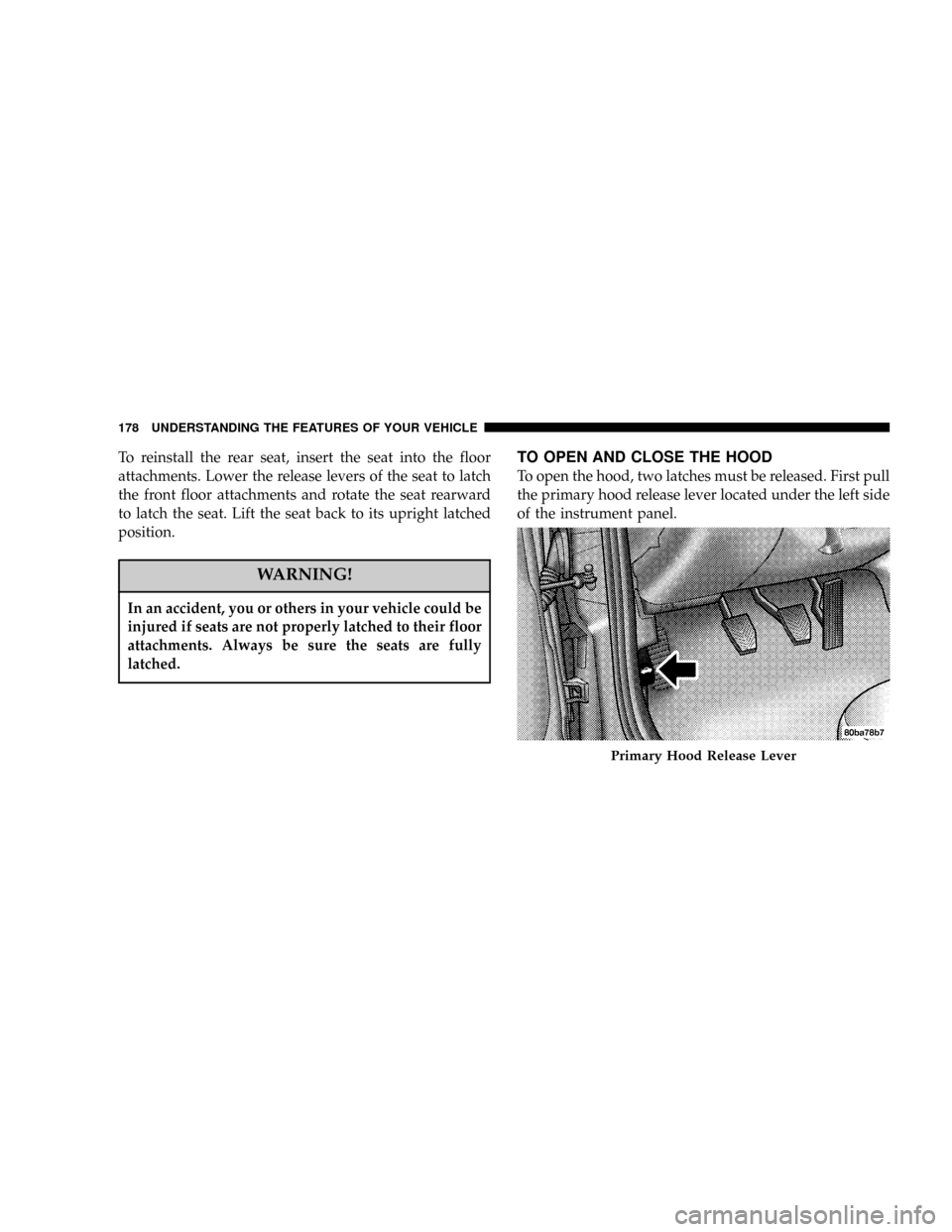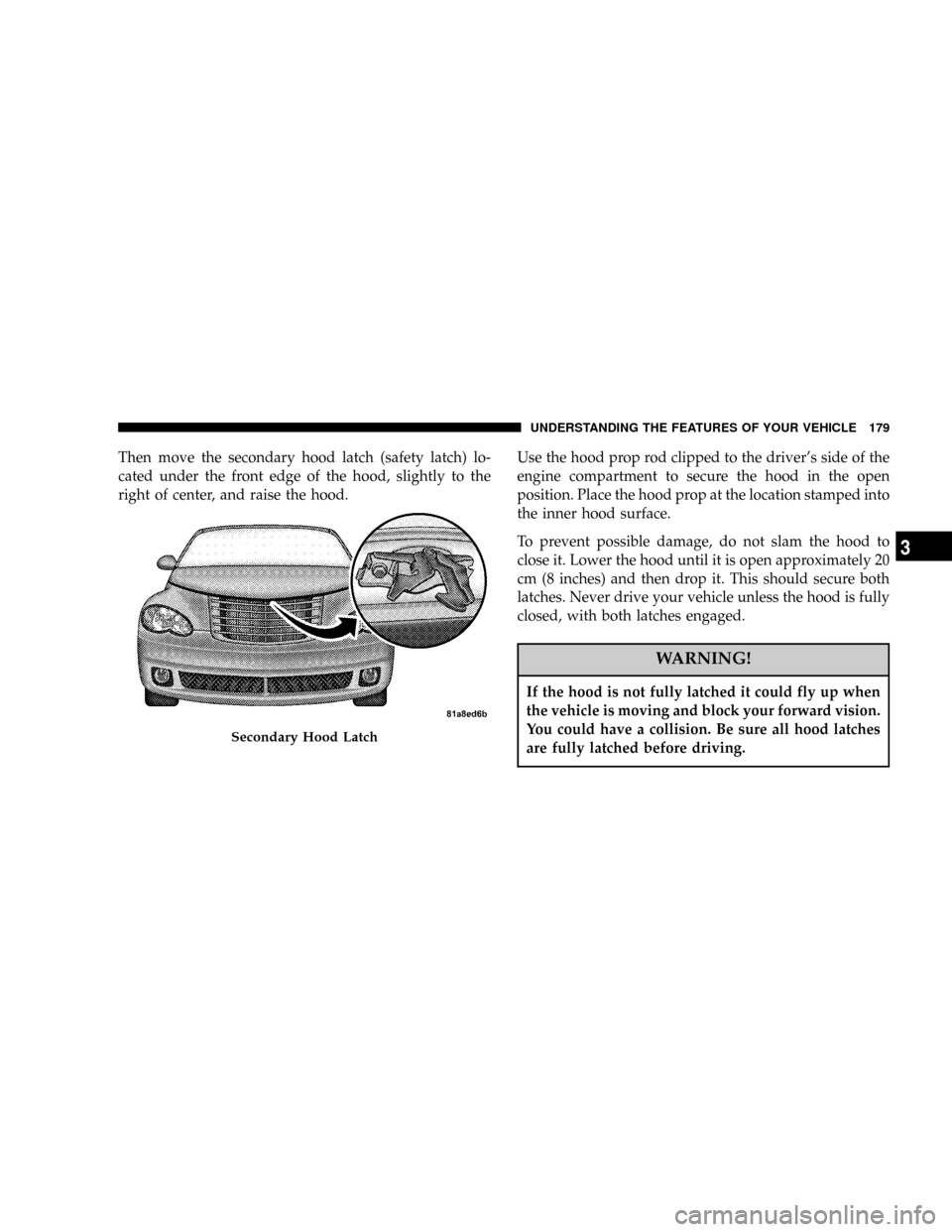open hood CHRYSLER PT CRUISER 2007 1.G Owners Manual
[x] Cancel search | Manufacturer: CHRYSLER, Model Year: 2007, Model line: PT CRUISER, Model: CHRYSLER PT CRUISER 2007 1.GPages: 467, PDF Size: 7.57 MB
Page 116 of 467

NUConnectŸ System Features.............145
NAdvanced Phone Connectivity............150
NThings You Should Know About Your
UConnectŸ System....................151
NGeneral Information...................159
mSeats................................160
NFront Seat Adjustment..................160
NPower Seat Adjuster Ð If Equipped........161
NManual LumbarÐIf Equipped............162
NFolding Front Passenger Seat Ð If Equipped . . 163
NDriver's Seat Back TiltÐIf Equipped........163
NPassenger Seat Back Tilt (Easy Entry System)
(Convertible)........................164
NAdjustable Head Restraints..............165NHeated Seats Ð If Equipped.............166
NFolding Rear Seat (Sedan)...............167
NFolding Rear Seat (Convertible)...........169
NTumbling Rear Seat (Sedan)..............170
NTumbling Rear Seat (Convertible)..........172
NRear Seat Removal (Sedan)..............176
mTo Open And Close The Hood.............178
mLights...............................180
NMap/Reading Lights (Sedan).............180
NMap/Reading Lights (Convertible).........181
NMulti-Function Control Lever.............181
NHeadlights, Parking Lights, Instrument Panel
Lights.............................182
116 UNDERSTANDING THE FEATURES OF YOUR VEHICLE
Page 178 of 467

To reinstall the rear seat, insert the seat into the floor
attachments. Lower the release levers of the seat to latch
the front floor attachments and rotate the seat rearward
to latch the seat. Lift the seat back to its upright latched
position.
WARNING!
In an accident, you or others in your vehicle could be
injured if seats are not properly latched to their floor
attachments. Always be sure the seats are fully
latched.
TO OPEN AND CLOSE THE HOOD
To open the hood, two latches must be released. First pull
the primary hood release lever located under the left side
of the instrument panel.
Primary Hood Release Lever
178 UNDERSTANDING THE FEATURES OF YOUR VEHICLE
Page 179 of 467

Then move the secondary hood latch (safety latch) lo-
cated under the front edge of the hood, slightly to the
right of center, and raise the hood.Use the hood prop rod clipped to the driver's side of the
engine compartment to secure the hood in the open
position. Place the hood prop at the location stamped into
the inner hood surface.
To prevent possible damage, do not slam the hood to
close it. Lower the hood until it is open approximately 20
cm (8 inches) and then drop it. This should secure both
latches. Never drive your vehicle unless the hood is fully
closed, with both latches engaged.
WARNING!
If the hood is not fully latched it could fly up when
the vehicle is moving and block your forward vision.
You could have a collision. Be sure all hood latches
are fully latched before driving.
Secondary Hood Latch
UNDERSTANDING THE FEATURES OF YOUR VEHICLE 179
3
Page 381 of 467

when the underside or rear of the vehicle is damaged;
have a competent technician inspect the complete ex-
haust system and adjacent body areas for broken, dam-
aged, deteriorated, or mispositioned parts. Open seams
or loose connections could permit exhaust fumes to seep
into the passenger compartment. In addition, inspect the
exhaust system each time the vehicle is raised for an oil
change or lubrication. Replace as required.
WARNING!
Exhaust gases can injure or kill. They contain carbon
monoxide (CO) which is colorless and odorless.
Breathing it can make you unconscious and can
eventually poison you. To avoid breathing CO, refer
to Exhaust Gas in the Safety Tips section of this
manual.
Cooling System
WARNING!
²When working near the radiator cooling fan, dis-
connect the fan motor lead or turn the ignition
switch to the OFF position. The fan is temperature
controlled and can start at any time the ignition
switch is in the ON position.
²You or others can be badly burned by hot coolant
or steam from your radiator. If you see or hear
steam coming from under the hood, don't open
the hood until the radiator has had time to cool.
Never try to open a cooling system pressure cap
when the radiator is hot.
MAINTAINING YOUR VEHICLE 381
7
Page 456 of 467

Gasoline (Fuel).......................321,410
Gasoline, Reformulated................... 323
Gauges
Coolant Temperature.................... 224
Fuel................................ 224
Odometer........................... 225
Tachometer.......................... 225
Gearshift.............................. 285
General Information....................17,159
General Maintenance..................... 367
Glass Cleaning.......................... 397
Gross Axle Weight Rating.................. 329
Gross Vehicle Weight Rating................ 329
Hands-Free Phone (UConnectŸ)............. 134
Hazard Warning Flasher................... 342
Head Restraints......................... 165
Headlights
Bulb Replacement...................... 406Cleaning............................ 397
High Beam........................185,230
High Beam/Low Beam Select Switch........ 185
Passing............................. 185
Switch.............................. 182
Heated Seats........................... 166
Hitches
Trailer Towing........................ 331
HomeLinkt(Garage Door Opener) Transmitter . . . 193
Hood Release.......................... 178
Hoses................................ 386
Ignition............................... 13
Key ................................. 13
Wiring System (Spark Plug Wires).......... 372
Ignition Key Removal..................... 13
Immobilizer (Sentry Key).................15,36
Infant Restraint.......................72,105
Information Center, Vehicle................. 231
456 INDEX
Page 467 of 467

INTRODUCTION INTRODUCTION HOW TO USE THIS MANUAL WARNINGS AND CAUTIONS VEHICLE IDENTIFICATION NUMBER VEHICLE MODIFICATIONS/ALTERATIONS THINGS TO KNOW BEFORE STARTING YOUR VEHICLE A WORD ABOUT YOUR KEYS
Ignition Key Removal
Locking Doors With The KeyKey-In-Ignition ReminderSENTRY KEY - IF EQUIPPED Replacement KeysSentry Key ProgrammingGeneral InformationSTEERING WHEEL LOCK - IF EQUIPPED If You Wish To Manually Lock The Steering WheelTo Release The Steering Wheel
LockAutomatic Transaxle Ignition Interlock SystemDOOR LOCKS Manual Door LocksPower Door LocksChild-Protection Door Lock System (Rear Doors) - IfEquippedREMOTE KEYLESS ENTRY (SEDAN) To unlock the doors and liftgateTo lock the doors and liftgate (if
equipped with power options) Using The Panic AlarmTo Turn Off Flash Lights With LockProgramming Additional TransmittersGeneral InformationBattery ReplacementREMOTE KEYLESS ENTRY (CONVERTIBLE) To Unlock the DoorsTo lock the doorsTo Unlatch the Deck
LidPanic AlarmUsing The Panic AlarmTo Turn Off Flash Lights With LockTo Program Additional TransmittersGeneral InformationTransmitter Battery ServiceSECURITY ALARM SYSTEM - IF EQUIPPED To set the alarmTo disarm the systemSecurity System Manual Override
LIFTGATE (SEDAN) DECK LID (CONVERTIBLE) Power Deck Lid Release (Convertible)EMERGENCY SEAT BACK RELEASE (SEDAN) EMERGENCY DECK LID RELEASE LATCH (CONVERTIBLE) POWER WINDOWS Auto Down FeatureRear Window SwitchesWind
BuffetingOCCUPANT RESTRAINTS (SEDAN) Lap/Shoulder BeltsAdjustable Upper Shoulder Belt AnchorageLap/Shoulder Belt Untwisting ProcedureSeat Belt PretensionersEnhanced Seat Belt Reminder System (BeltAlert) Seat Belts And Pregnant WomenDriver and Front
Passenger Supplemental Restraint System (SRS) - AirbagChild RestraintOCCUPANT RESTRAINTS (CONVERTIBLE) Lap/Shoulder BeltsLap/Shoulder Belt Untwisting ProcedureSeat Belt PretensionersEnhanced Seat Belt Reminder System (BeltAlert) Seat Belts And
Pregnant WomenDriver and Front Passenger Supplemental Restraint System (SRS) - AirbagChild RestraintENGINE BREAK-IN RECOMMENDATIONS SAFETY TIPS Exhaust GasSafety Checks You Should Make Inside The VehiclePeriodic Safety Checks You Should Make
Outside The VehicleUNDERSTANDING THE FEATURES OF YOUR VEHICLE CONVERTIBLE TOP OPERATION To Lower The TopTo Raise The TopConvertible Top Boot Cover Installation-If EquippedConvertible Top Boot Cover Removal and StorageCONVERTIBLE TOP
MANUAL OVERRIDEMIRRORS Inside Day/Night Mirror - If EquippedOutside Mirror-Drivers SideOutside Mirror-Passengers SideElectric Remote-Control Mirrors - If EquippedIlluminated Vanity Mirrors - If EquippedSun Visor Sliding FeatureHANDS-FREE COMMUNICATION
(UConnect) - IF EQUIPPED OperationsPhone Call FeaturesUConnect System FeaturesAdvanced Phone ConnectivityThings You Should Know About Your UConnect SystemGeneral InformationSEATS Front Seat AdjustmentPower Seat Adjuster - If EquippedManual
Lumbar-If EquippedFolding Front Passenger Seat - If EquippedDrivers Seat Back Tilt-If EquippedPassenger Seat Back Tilt (Easy Entry System) (Convertible)Adjustable Head RestraintsHeated Seats - If EquippedFolding Rear Seat (Sedan)Folding Rear Seat (Convertible)
Tumbling Rear Seat (Sedan)Tumbling Rear Seat (Convertible)Rear Seat Removal (Sedan)TO OPEN AND CLOSE THE HOOD LIGHTS Map/Reading Lights (Sedan)Map/Reading Lights (Convertible)Multi-Function Control LeverHeadlights, Parking Lights, Instrument Panel
LightsDaytime Running Lights (DRL) - If EquippedLights-on ReminderFog Lights - If Equipped Turn Signals Highbeam/Lowbeam Select Switch Passing LightWINDSHIELD WIPERS AND WASHERS Windshield WashersMist Feature Windshield Wiper OperationIntermittent
Wiper SystemTILT STEERING COLUMN ELECTRONIC SPEED CONTROL - IF EQUIPPED To ActivateTo Set At A Desired SpeedTo DeactivateTo Resume SpeedTo Vary The Speed SettingManual TransaxleTo Accelerate For PassingGARAGE DOOR OPENER - IF
EQUIPPED Programming The Universal TransceiverRolling Code ProgrammingCanadian Programming/Gate ProgrammingOperationReprogramming A Single ButtonSecurityPOWER SUNROOF - IF EQUIPPED Express Open FeatureWind BuffetingSunroof Maintenance
ELECTRICAL POWER OUTLETS Electrical Outlet Use With Engine OffCONSOLE FEATURES STORAGE Center Console/Armrest Storage Bin Storage PocketsREAR SHELF PANEL- IF EQUIPPED Position 1 (Top)Position 2 (Middle)Position 3 (Floor)Position 4 (Vertical) Position 5 (table)ROOF LUGGAGE RACK - IF EQUIPPED REAR WINDOW FEATURES Electric Rear Window Defroster Rear Wiper/Washer Switch - If EquippedAdding Washer FluidUNDERSTANDING YOUR INSTRUMENT PANEL INSTRUMENT PANEL FEATURES
INSTRUMENT CLUSTER-BASE INSTRUMENT CLUSTER-PREMIUM INSTRUMENT CLUSTER-TURBO INSTRUMENT CLUSTER DESCRIPTIONS ELECTRONIC VEHICLE INFORMATIONCENTER (EVIC)-If Equipped EVIC Functions Compass/Temperature/Audio
Average Fuel EconomyDistance To Empty (DTE)Elapsed TimePersonal Settings (Customer Programmable Features)SETTING THE ANALOG CLOCK RADIO GENERAL INFORMATION Radio Broadcast SignalsTwo Types of SignalsElectrical DisturbancesAM Reception
FM ReceptionSALES CODE REF - AM/FM/CD (SINGLE DISC) RADIO WITH OPTIONAL SATELLITE RADIO AND HANDS FREE PHONE CAPABILITY Operating Instructions - Radio ModeOperation Instructions - CD ModeOperation Instructions - Auxiliary ModeOperating
Instructions - Hands Free Phone - If EquippedOperating Instructions - Satellite Radio - If EquippedSALES CODE RAQ - AM/FM/CD (6-DISC) RADIO WITH OPTIONAL SATELLITE RADIO, HANDS FREE PHONE, AND VEHICLE ENTERTAINMENT SYSTEMS (VES)
CAPABILITIES Operating Instructions - Radio ModeOperation Instructions - (CD MODE for CD Audio Play)LOAD/EJECT Button (CD Mode for CD Audio Play)Notes On Playing MP3 FilesOperation Instructions - (CD Mode for MP3 Audio Play)LOAD/EJECT Button (CD Mode
for MP3 Play)SATELLITE RADIO - IF EQUIPPED System ActivationElectronic Serial Number/Sirius Identification Number (ESN/SID)Selecting Satellite Mode in REF, and RAQ, RadiosSelecting a ChannelStoring and Selecting Pre-Set ChannelsUsing the PTY (Program Type)
Button (if equipped)PTY Button SCANPTY Button SEEKSatellite AntennaReception QualityCD/DVD DISC MAINTENANCE RADIO OPERATION AND CELLULAR PHONES CLIMATE CONTROLS Climate ControlsOperating Tips STARTING AND OPERATING STARTING
PROCEDURES Automatic TransaxleManual TransaxleNormal StartingExtremely Cold Weather (below -20 degrees F or -29 degrees C)If Engine Fails to StartAfter StartingTurbocharger Cool DownAUTOMATIC TRANSAXLE - IF EQUIPPED Brake/Transmission Interlock
SystemAutomatic Transaxle Ignition Interlock SystemFour Speed Automatic TransaxleReset ModeGear Ranges For Four Speed Automatic TransaxleAUTOSTICK - IF EQUIPPED Autostick OperationAutostick General InformationMANUAL TRANSAXLE OPERATION 2.4
Liter Turbo- If Equipped Recommended Shift SpeedsDownshiftingPARKING BRAKE BRAKE SYSTEM Anti-Lock Brake System (ABS) - If EquippedPOWER STEERINGTRACTION CONTROL SYSTEM - IF EQUIPPED TIRE SAFETY INFORMATION Tire Markings Tire
Identification Number (TIN)Tire Loading and Tire PressureTIRES - GENERAL INFORMATION Tire PressureTire Inflation PressuresRadial-Ply TiresCompact Spare Tire - If EquippedLimited Use Spare - If EquippedTire SpinningTread Wear IndicatorsLife of TireReplacement
TiresAlignment And BalanceTIRE CHAINS SNOW TIRES Tire Rotation Recommendations FUEL REQUIREMENTS 2.4L Standard Engine and 2.4L Standard Turbo Engine2.4L High Output Turbo EngineReformulated GasolineGasoline/Oxygenate BlendsMMT In Gasoline
Materials Added to FuelFuel System CautionsCarbon Monoxide WarningsADDING FUEL Fuel Filler Cap (Gas Cap)Loose Fuel Filler Cap MessageVEHICLE LOADING TRAILER TOWING Common Towing DefinitionsTrailer Hitch ClassificationTrailer Towing Weights
(Maximum Trailer Weight Ratings)Trailer and Tongue WeightTowing RequirementsTowing TipsRECREATIONAL TOWING (BEHIND MOTORHOME, ETC.) Towing This Vehicle Behind Another Vehicle (Flat towing with all four wheels on the ground)WHAT TO DO IN
EMERGENCIES HAZARD WARNING FLASHER IF YOUR ENGINE OVERHEATS JACKING AND TIRE CHANGING Jack LocationSpare Tire StowagePreparations For JackingJacking InstructionsJUMP-STARTING PROCEDURES DUE TO A LOW BATTERY DRIVING
ON SLIPPERY SURFACES AccelerationTractionFREEING A STUCK VEHICLE TOWING A DISABLED VEHICLE With Ignition KeyWithout The Ignition KeyCONVERTIBLETOP MANUAL OVERRIDE MAINTAINING YOUR VEHICLE 2.4L TURBO ENGINE COMPARTMENT
2.4L ENGINE COMPARTMENT ONBOARD DIAGNOSTIC SYSTEM - OBD II Loose Fuel Filler Cap MessageEMISSIONS INSPECTION AND MAINTENANCE PROGRAMS REPLACEMENTPARTS DEALER SERVICE MAINTENANCE PROCEDURES Engine OilDrive Belts
- Check Condition and TensionSpark PlugsIgnition Wiring SystemCatalytic ConverterEngine Timing BeltCrankcase Emission Control SystemFuel FilterAir Cleaner Element (Filter)Maintenance-Free BatteryAir Conditioner MaintenancePower Steering - Fluid CheckFront
Suspension Ball JointsBody LubricationWindshield Wiper BladesWindshield Washer ReservoirExhaust SystemCooling SystemHoses And Vacuum/VaporHarnessesFuel System ConnectionsBrake SystemAutomatic TransaxleManual TransaxleAppearance Care And
Protection From CorrosionCONVERTIBLE TOP CARE WashingGeneral CleaningCloth Top Additional Cleaning ProcedureCloth Top ProtectionWeather Strip CareINTEGRATED POWER MODULE (IPM) VEHICLE STORAGE REPLACEMENT BULBS BULB REPLACEMENT
HeadlightsFront Park/Turn Signal/Side Marker LightsFront Fog Lights - If EquippedTail/Stop, and Rear Turn Signal LightsBack Up Lights Center HighMounted Stop LightFLUIDS AND CAPACITIES FLUIDS, LUBRICANTS AND GENUINE PARTS EngineChassis
MAINTENANCE SCHEDULES EMISSION CONTROL SYSTEM MAINTENANCE MAINTENANCE SCHEDULE SCHEDULE B-ALL ENGINESSCHEDULE A-NON TURBOSCHEDULE A-TURBOIF YOU NEED CONSUMER ASSISTANCE SUGGESTIONS FOR OBTAINING
SERVICE FOR YOUR VEHICLE Prepare For The AppointmentPrepare A ListBe Reasonable With RequestsIF YOU NEED ASSISTANCE WARRANTY INFORMATION (U.S. Vehicles Only) MOPAR PARTS REPORTING SAFETY DEFECTS In CanadaPUBLICATION ORDER
FORMS DEPARTMENT OF TRANSPORTATION UNIFORM TIRE QUALITY GRADES TreadwearTraction GradesTemperature GradesINDEX